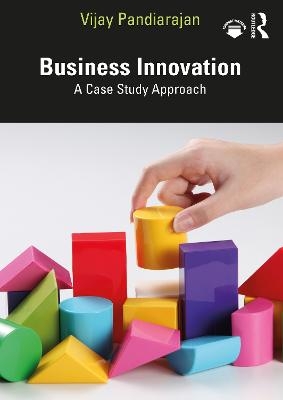
Business Innovation
Routledge (Verlag)
978-1-032-04187-2 (ISBN)
This book provides an understanding of innovation models and why they are important in the business context, and considers sources of innovation and how to apply business frameworks using real-world examples of innovation-led businesses.
After providing a solid background to the key concepts related to innovation models, the book looks at why innovation takes place and where the sources of innovation lie, from corporate research to crowd-sourced and government-funded initiatives. Innovation models across manufacturing, services and government are explored, as well as measuring innovation, and the impact of design thinking and lean enterprise principles on innovation and sustainability-driven imperatives.
Offering a truly comprehensive and global approach, Business Innovation should be core or recommended reading for advanced undergraduate, postgraduate, MBA and Executive Education students studying Innovation Management, Strategic Management and Entrepreneurship.
Vijay Pandiarajan is a faculty member of the Technology & Operations department at the Ross School of Business, The University of Michigan, Ann Arbor, Michigan, USA. He focuses on teaching and researching Innovation and Technology. Before joining the Ross School faculty, he held leadership positions at various global companies, including at Accenture, Verizon, and Whirlpool Corporation. His educational highlights include a Sloan Fellows MBA degree from the Massachusetts Institute of Technology (MIT) Sloan School of Management, USA, with a focus on Technology and Innovation; a PhD in Industrial Engineering from the West Virginia University, USA; a Master’s degree in Aircraft Production Technology from the Indian Institute of Technology, Madras, India; and a bachelor's degree with Honors in Mechanical Engineering from the University of Madras, Chennai, India. He built Jaguar fighter planes at Hindustan Aeronautics Ltd, collaborating with British Aerospace, Safran (previously Turbomeca), and Rolls Royce before pursuing his doctoral studies.
Part I – "What" - Introduction to Innovation
1. Chapter 1 - Innovation – General Background
1.1 Introduction
1.2 Invention Vs Innovation
1.3 Historical Perspectives of Innovation
1.4 Is innovation limited to Products?
1.5 Innovation in Service
1.6 Concluding Remarks
1.7 References
2. Chapter 2 - Models of Innovation
2.1 Introduction
2.2 Cosmetic/Survival Innovation
2.3 Leap forward Innovation
2.4 Disruptive Innovation
2.4.1 Low-end disruptive innovation
2.4.2 Nascent market disruptive innovation
2.5 Seismic Innovation
2.6 Innovation – What has changed Now?
2.7 Concluding Remarks
2.8 References
3. Chapter 3 – Challenges Embracing Innovation
3.1 Introduction
3.2 Triangular Dilemma
3.3 Market Innovation Challenges
3.3.1 Sticky Customers
3.3.2 Predictable M&A
3.3.3 Stable Supply Chain
3.4 Organizational Innovation Challenges
3.4.1 Lack of Coordinated Innovation Strategy
3.4.2 Lack of Diversity
3.4.3 Compartmentalization
3.4.4 Risk Averse Non-Experimental Culture
3.4.5 Misaligned Incentive
3.4.6 Micromanagement
3.4.7 Span of Control
3.4.8 Lack of Sense of Urgency
3.5 Stakeholder Innovation Challenges
3.5.1 Investor Community
3.5.2 Government
3.5.3 Local Ecosystem
3.5.4 Employees
3.6 Concluding Remarks
3.7. References
Part II – "Why" – Innovation Imperatives
4. Chapter 4 – Innovation – A Key to Business Success
4.1 Introduction
4.2 New Economic Paradigm
4.3 Consumers Are Changing
4.4 Competitive Landscape Changes
4.5 Shorter Product Life Spans
4.6 Globalization Vs Localization
4.7 Digital Tsunami
4.8 Technology Shaping the Business Core
4.9 Dynamic Capabilities
4.10 Concluding Remarks
4.11 References
Part III – "Where" – Sources of Innovation
5. Chapter 5 – Sources of Innovation
5.1 Introduction
5.2 Corporate Research and Development
5.3 Organizational Processes and Ecosystems - Integrated Value Chain
5.4 Corporate Values and Culture
5.5 Partnership and Open Innovation
5.6 Strategic Resources & Talent Architecture
5.7 Operating Model (Governance, KPI, Structure, Accountability etc.)
5.8 Concluding Remarks
5.9 References
Part IV – "How" – Approach to Advance Innovation
6. Chapter 6 - Framework Based Innovation Approach
6.1 Introduction
6.2 Innovation in Action
6.3 Factors Impacting Innovation
6.4 TRIAL© Holistic Framework for Innovation
6.4.1 TRIAL© – Framework Innovation Dimensions
6.4.2 VASTEFA© Leadership Framework
6.5 Concluding Remarks
6.6 References
Part V – Innovations in Industry Verticals
7. Chapter 7 – Innovations in Manufacturing
7.1 Introduction
7.2 Pharmaceuticals
7.3 Heavy Equipment
7.4 Automotive
7.5 Semiconductor
7.6 Concluding Remarks
7.7 References
8. Chapter 8 – Innovations in Service Industry
8.1 Introduction
8.2 Service Trend
8.3 Healthcare
8.4 Retail
8.5 Hospitality
8.6 Education
8.7 Wellness
8.8 Banking
8.9 Transportation
8.10 Concluding Remarks
8.11 References
9. Chapter 9 – Innovations in Government
9.1 Introduction
9.2 Modalities of Community Service – Mass Vs Personalized
9.3 Citizen-Government Redefined Boundaries
9.4 Digital Thread and Realtime Alerts
9.5 Smart Cities
9.6 Concluding Remarks
9.7 References
Part VI – Economics of Innovation
10. Chapter 10 – Measuring Innovation
10.1 Introduction
10.2 Traditional KPIs
10.3 Innovation Risk Vs Reward – A Balanced Approach
10.4 How to Value Innovation – Organic Vs M&A Scenarios
10.5 Concluding Remarks
10.6 References
Part VII – Special Topics on Innovation
11. Chapter 11 - Design Thinking
11.1 Introduction
11.3 Design Thinking for Innovation – Why Now?
11.3 Design Thinking Approach
11.4 Success Stories – Where Design Thinking Advanced Innovation
11.4.1 Airbnb
11.4.2 Ericsson
11.4.3 Burberry
11.4.4 Nordstrom
11.4.5 Bank of America - Keep the Change Program
11.5 Concluding Remarks
11.6 References
12. Chapter 12 - Lean Enterprise and Innovation
12.1 Introduction
12.2 Lean and Innovation- Are they Mutually Exclusive?
12.3 How Lean Accelerates Innovation?
12.4 Success Stories – Where Lean Thinking Advanced Innovation?
12.4.1 Pixar Animation Studios
12.4.2 Dropbox
12.4.3 Zappos
12.4.4 General Electric
12.5 Concluding Remarks
12.6 References
13. Chapter 13 – Sustainability-focused Innovation
13.1 Introduction
13.2 Evolving Market Orientation Towards Sustainability – Gen Z
13.3 Sustainability – A New Secular Growth Driver
13.4 Success Stories – Sustainability Focused Innovation
13.4.1 The Procter & Gamble Company (P&G)
13.4.2 Patagonia
13.4.3 Braskem (Brazil)
13.4.4 Colorifix (UK)
13.5 Concluding Remarks
13.6 References
Part VIII – Case Studies
Case 1: Amgen - Biosimilar Innovations – By Kavya Sivan
Case 2: FedEx: Innovation Through Sustained Adaptability – By Alaina Gregory
Case 3: Reliance Jio: From 4G to Digital Innovation - By Hursh Motwani
Case 4: Stryker Case Study: Design Thinking Response to COVID-19 – By Kyle Geiger
Case 5: Whirlpool - A History of Sustained Innovation from Within – By Malik Abbasi
Case 6: Apple’s Swift: A Programming Language Innovation for the Future – By Maxwell Cornellier
Case 7: Microsoft: The Age of Nadella – By Serena Wang and Minnie Sun
Case 8: The Procter & Gamble Company – A Unique Innovation Approach – By Minnie Sun and Serena Wang
Case 9: Timberland - Sustainable Innovation – By Drew Arnson
Case 10: Zara-Inditex – Fast-Fashion Done Right – By Rocco Pelà
Case 11: Patagonia - Leader of a Sustainable Business – By Suzanna Yik
Case 12: Amazon - Head in the Cloud: Transformation Through Leadership’s Lens – By William McCrone
Case 13: Ericsson’s Innovation through M&A – By Derek Kuo
Case 14: Samsung’s New Age Innovation Using Organization and Culture – By Derek Kuo
Case 15: Sun Pharma Industries – Innovation through Specialty acquisition strategy, technology, leadership, and culture - By Katie Kuhlman
Case 16: Ecovative Design – Sustainable Business – By Daniel Meeks
| Erscheinungsdatum | 27.01.2022 |
|---|---|
| Zusatzinfo | 1 Tables, black and white; 60 Line drawings, black and white; 6 Halftones, black and white; 66 Illustrations, black and white |
| Verlagsort | London |
| Sprache | englisch |
| Maße | 174 x 246 mm |
| Gewicht | 594 g |
| Themenwelt | Mathematik / Informatik ► Mathematik ► Finanz- / Wirtschaftsmathematik |
| Technik | |
| Wirtschaft ► Betriebswirtschaft / Management ► Unternehmensführung / Management | |
| Wirtschaft ► Volkswirtschaftslehre | |
| ISBN-10 | 1-032-04187-0 / 1032041870 |
| ISBN-13 | 978-1-032-04187-2 / 9781032041872 |
| Zustand | Neuware |
| Haben Sie eine Frage zum Produkt? |
aus dem Bereich


